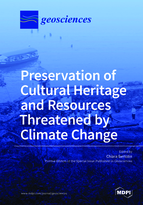Preservation of Cultural Heritage and Resources Threatened by Climate Change
A special issue of Geosciences (ISSN 2076-3263). This special issue belongs to the section "Geoheritage, Geoparks and Geotourism".
Deadline for manuscript submissions: closed (6 July 2018) | Viewed by 68005
Special Issue Editor
Interests: biomimetic and bioinspired design; built environment; LCA; durability
Special Issues, Collections and Topics in MDPI journals
Special Issue Information
Dear Colleagues,
We agree that transmitting our cultural heritage as a manifest source of our common history and identity to future generations, by protecting physical representations of past events and people, is a crucial obligation of our generation. The Council of Europe's European Heritage Strategy for the 21st Century calls for more reliable quantified information on the impact of climate change on cultural heritage as the changing climate is affecting the cultural tourism sector, the organizations who take care of the Cultural Heritage—with difficulties in managing indoor environments caused by increasing costs and lack of funds—local and regional economies, their traditional practices, as well as their use of resources and adaptation planning options.
The Special Issue of Geosciences titled: “Preservation of Cultural Heritage and Resources Threatened by Climate Change” has been launched to take stock of the existing, but still fragmentary knowledge on this challenge—at European level only two projects, Noah`s Ark (2007), and Climate for Culture, (2014) finalized their research on these issues—and to enable the heritage community to respond to the implementation of the Paris Climate agreement.
Additional research, to assess past and future weather-related events affecting cultural heritage is needed to document experience of how cultural heritage were affected and responded to changing climate (e.g., using previous data surveys, archival data, photographs), and to plan long-term management scenarios of heritage sites on the base of future climate change projections.
These outcomes will help in identifying the most important resulting risks together with the opportunities of exploiting new tools for adapting to a changing climate. Outcomes ask for a better understanding of naturally-aged material response to environmental changes, development of evidence-based risk assessment software, sustainable methodological approaches of adaptation interventions at larger scale, as well as use of remote sensing satellite data to estimate long-term risks worldwide.
This Special Issue of Geosciences aims to gather high-quality original research articles, reviews and technical notes on experimental research and/or case studies with respect to the above described challenges. Depending on your main focus, a wide choice of methods (e.g., GIS and remote sensing, models/simulations, field survey, participatory-based, sampling and experimental based) and spatial range (e.g., from landscape/ district to site/ building, up to collections, objects and materials scale) can be applied on data analysis. Possible topics of interest for the special issue are the following:
- Document how the implementation of cultural heritage adaptation or preservation is taking place at different scales in a changing climate.
- Document how the lesson learned from previous climate change responses at heritage site can help in informing decision-making managers and stakeholders to plan future most effective adaptation interventions.
- Point out the analysis of use of resources during preventive and/or remedial interventions. Is there any clear demarcation threshold in decision-making when applying low level conservative intervention or high-level adaptation interventions?
- Propose an effective procedure to document the ongoing effect of climate change on cultural heritage at different scale. Point out differences in protocols to be established for movable and immovable cultural heritage
- Methods/tools to assess/measure climate change induced impacts on cultural heritage with slow and cumulative effects (e.g., sea level rise, coastal erosion, changing air temperature and humidity) and/or immediate and drastic effects (e.g., floods, hurricanes, storms and droughts).
- Methods/tools to distinguish between the “normal” weathering materials (i.e., standard material lifetime) and the “additional” weathering induced by the ongoing climate change effect.
- Barriers, limits and constraints in comparing results on climate-induced decay on naturally-aged materials (real environment) with results on climate-induced decay on samples constituted of new or thermally aged materials (laboratory environment).
- Temporal scale of preservation/adaptation—short and long-term challenges and methodological approaches to enhance sustainable preservation and adaptation of cultural heritage (e.g., through simulation of future climate change effects, control of climate-induced decay, optimization of materials re-use in conservation interventions).
- Use of a multiple-level rating method to evaluate climate change effect on cultural heritage that includes climate-induced decay on heritage material, as well as historical and cultural value to better assist decision-making managers in choosing adaptation and preservation interventions.
Assoc. Prof. Chiara Bertolin
Guest Editor
Manuscript Submission Information
Manuscripts should be submitted online at www.mdpi.com by registering and logging in to this website. Once you are registered, click here to go to the submission form. Manuscripts can be submitted until the deadline. All submissions that pass pre-check are peer-reviewed. Accepted papers will be published continuously in the journal (as soon as accepted) and will be listed together on the special issue website. Research articles, review articles as well as short communications are invited. For planned papers, a title and short abstract (about 100 words) can be sent to the Editorial Office for announcement on this website.
Submitted manuscripts should not have been published previously, nor be under consideration for publication elsewhere (except conference proceedings papers). All manuscripts are thoroughly refereed through a single-blind peer-review process. A guide for authors and other relevant information for submission of manuscripts is available on the Instructions for Authors page. Geosciences is an international peer-reviewed open access monthly journal published by MDPI.
Please visit the Instructions for Authors page before submitting a manuscript. The Article Processing Charge (APC) for publication in this open access journal is 1800 CHF (Swiss Francs). Submitted papers should be well formatted and use good English. Authors may use MDPI's English editing service prior to publication or during author revisions.






